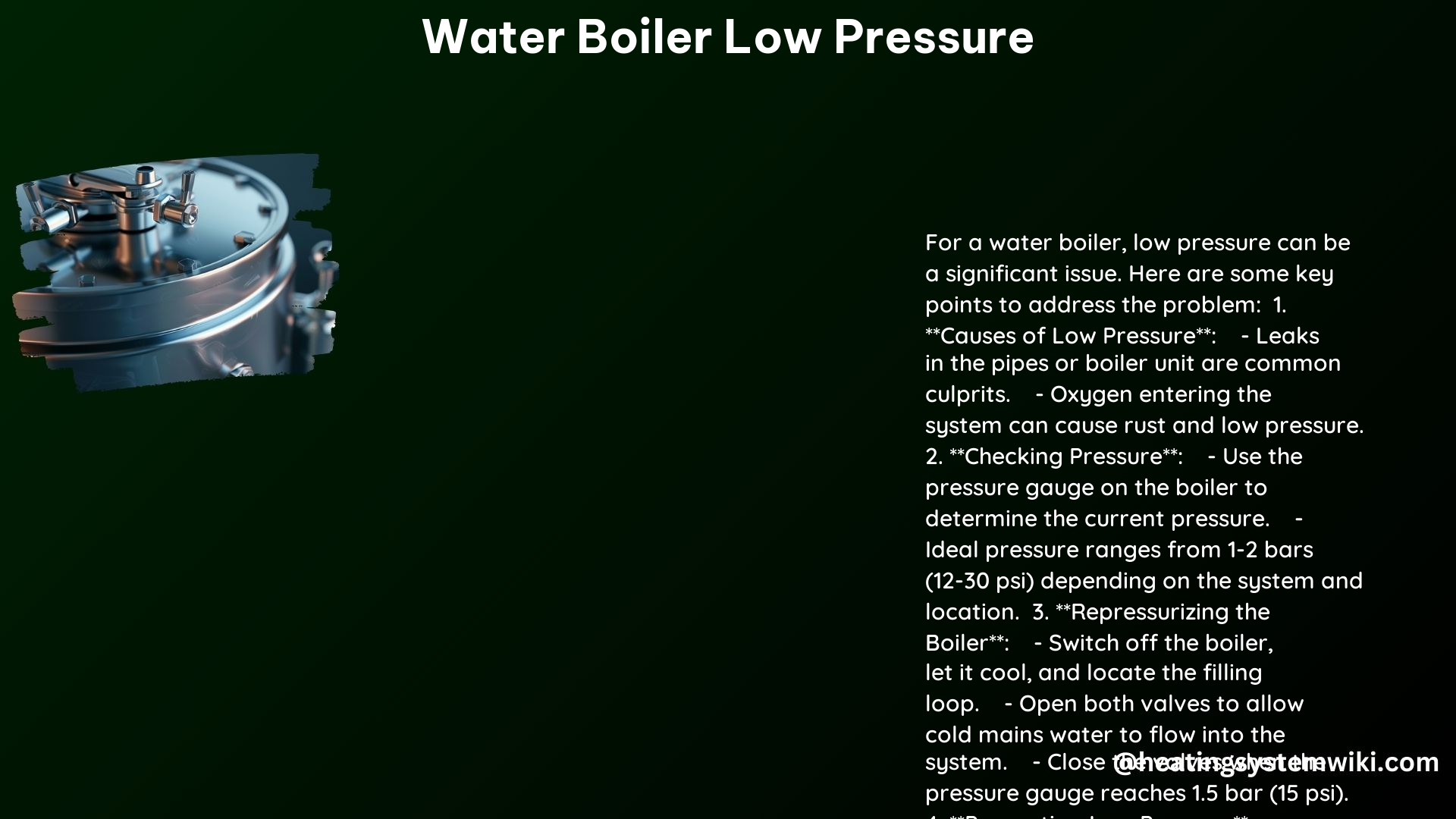As a seasoned expert on water boiler systems, I’m excited to share a comprehensive guide on tackling the common issue of low boiler pressure. Whether you’re a homeowner or a DIY enthusiast, this article will equip you with the knowledge and tools to diagnose and fix low boiler pressure, ensuring your heating system operates at peak efficiency.
Causes of Low Boiler Pressure
1. Leaks in the System
Leaks in the pipes or the boiler unit itself can be a primary culprit for daily pressure dips. These leaks can occur due to various factors, such as corrosion, wear and tear, or even improper installation. To identify the source of the leak, thoroughly inspect the pipes and the boiler unit for any signs of water damage, rust, or visible cracks.
2. Faulty Filling Loop
The filling loop is a crucial component responsible for repressurizing the boiler. If this loop is not functioning correctly, it can prevent the system from maintaining the desired pressure. Ensure that the filling loop is operating as per the manufacturer’s instructions, and consider replacing it if it’s found to be faulty.
3. Automatic Air Vent Leaks
The automatic air vent is designed to release excess air from the system, but if it’s leaking, it can lead to a gradual loss of pressure. Inspect the air vent for any signs of leakage and replace it if necessary.
Symptoms of Low Boiler Pressure

1. Cold Water Pressure
One of the most obvious signs of low boiler pressure is a reading below 1 bar on the pressure gauge when the boiler is cold. The ideal cold water pressure range is typically between 1-2 bars, so a reading outside of this range indicates a problem.
2. Heating Issues
Low boiler pressure can significantly impact the performance of the central heating system. If the heating system is not working correctly or producing unusual noises, it could be a sign of low pressure.
3. Gurgling Sounds
Gurgling or bubbling sounds in the pipes can be a telltale sign of air in the system, which is often a result of low boiler pressure. This air can prevent the proper circulation of hot water, leading to uneven heating and potential system damage.
Fixing Low Boiler Pressure
1. Check the Pressure Gauge
Ensure that the pressure gauge is accurate and not faulty. Consult the user manual for the correct procedure to check the pressure gauge and, if necessary, replace it to get an accurate reading.
2. Repressurize the Boiler
To repressurize the boiler, follow these steps:
1. Switch off the boiler and allow it to cool completely.
2. Open the filling loop valves to allow cold mains water into the system.
3. Close the valves when the pressure gauge reaches 1.5 bar.
4. Switch the boiler back on and press the reset button if necessary.
3. Check for Leaks
Carefully inspect the pipes and boiler for any signs of leaks or corrosion. Repair or replace any damaged components to prevent further pressure loss.
Technical Specifications
1. Ideal Pressure Range
The ideal pressure range for a boiler is typically between 1-2 bars when the system is cold. However, the pressure can rise to around 20 psi (1.4 bar) when the boiler is in operation.
2. Pressure Gauges
Boiler pressure gauges usually have red sections indicating high or low pressure limits. The green zone on the gauge indicates the optimal pressure range, which should be the target for your system.
3. Expansion Tanks
Expansion tanks play a crucial role in maintaining the correct boiler pressure. These tanks should be set to the appropriate pressure, usually around 12 psi (0.8 bar). Ensure that the expansion tank is not empty and that the check valve next to it is not leaking.
By following the steps outlined in this comprehensive guide, you’ll be well on your way to diagnosing and fixing low boiler pressure. Remember, safety should always be your top priority when working with any heating system. If you’re unsure or uncomfortable with any of the procedures, it’s best to consult a professional for assistance.
References
- Boiler Central. (2024). Low Boiler Pressure Causes, Fixes And How To Top It Up Yourself. Retrieved from https://www.boilercentral.com/troubleshooting/low-boiler-pressure/
- DoItYourself.com. (2023). Low Pressure in Boiler. Retrieved from https://www.doityourself.com/forum/boilers-home-heating-steam-hot-water-systems/645072-low-pressure-boiler.html
- Trusteyman. (2019). What Your Boiler Pressure Should Be When It’s Heated. Retrieved from https://trusteyman.com/blog/what-your-boiler-pressure-should-be-when-its-heated/
